Building a strong and functional core is essential for every lifter and athlete. Regardless of training age, ability level, and goals, there are a few key exercises that every beginner should master. In doing so, they will improve their midline stability, core muscle recruitment, and enhance postural control of the spine, pelvis, and surrounding areas.
In this article, we will offer lifters (and coaches) a few beginner friendly core exercises that can be used to increase core strength and stability, reinforce proper spinal alignment in loaded lifts, and improve overall athletic performance:
- Reasons Why Beginners Should Train Core
- Muscles Worked by Core Exercises
- Beginner Friendly Core Exercises
3 Reasons Why Beginners Should Train Core?
Below are just a few of the top benefits that beginners gain expect to gain when performing any of the beginner friendly core exercises below.
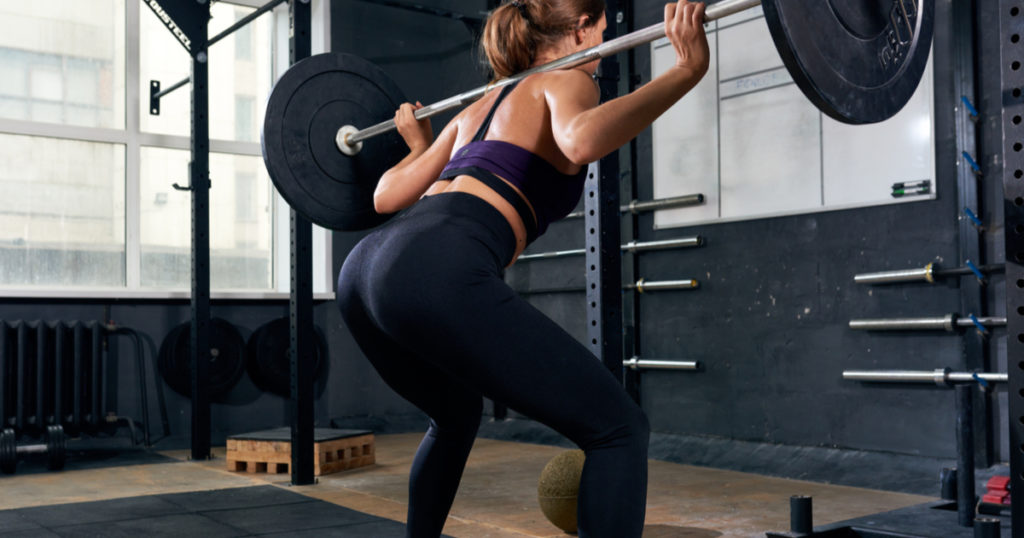
1. Core Strength and Stability
Core strength and stability is essential for all strength, power, fitness, and everyday lifters. In order to produce force during lifts, athletics, and everyday movements; the core and pelvis must be stable to allow for maximal force outputs at the surrounding joints.
Core training is a great way to develop awareness and strength in the superficial and deeper muscles of the torso; all of which can aid in strength output, athletic performance, injury prevention, and aesthetics.
2. Injury Prevention
The core muscles are responsible for overall core stabilization, rigidity in the spine under loads, and minimizing spinal stress.
Athletes and lifters who have lower back and/or hip issues in training can often suffer from poor posture, spinal stability, and core strength; all of which can be impacted by the the below core activation, postural awareness, and bracing exercises.
3. Stronger, More Powerful Movements
Once you develop core stability and sound movement efficiency, you will allow your body to express force in a wide variety of ways. For some, this may mean extreme demonstrations of strength and core stability/rigidity, while others may need dynamic core stability and strength. Powerlifters, weightlifters, sport athletes, and everyday lifters can benefit from increasing core stability and posture using the below beginner friendly core exercises to maximize performance.
Muscles Worked – Core Exercises
Below are the main muscle groups involved in most core exercises. Note, that certain movements (spinal flexion, extension, anti-rotation, etc) will be done using certain muscles over the others.
Rectus Abdominis
The rectus abdominis is often the muscle most people think of when they say “abs”, however these are just one piece of the core structure. The rectus abdominis is a superficial muscle that runs vertically along the anterior aspect of the torso and is responsible for spinal flexion and aids in resisting spinal extension (eccentric strength).

Obliques (Internal and External)
The obliques run diagonally along the torso, and are responsible in both rotation and anti-rotation of the torso. Both the internal and external obliques work to stabilize the pelvis under most loaded movements, but can also be powerful muscles for athletic endeavors such as running, sprinting, jumping, and rotational sports.
Without proper firing and development of the obliques, the torso and spine may rotate under load or explosive movements, creating potentially harmful rotational and shearing forces on the spine and lumbar discs.
Transverse Abdominis
The transverse abdominis is a deep muscle that runs along the anterior aspect of the torso. This exercise is responsible for aiding in core stability and postural strength. This muscle can be developed using proper bracing techniques, isometric core training, and loaded movements.
Spinal Erectors
While we cannot see this from the front, the spinal erectors are largely responsible for keeping the torso upright both with and without loading. These muscles must be trained to fire properly in order to aid in resistance training, loaded movements, and everyday posture.
Quadratus Lumborum
The quadratus lumborum (QL) is a deep muscle of the core that runs vertically along the posterior aspect of the pelvis/spine. This muscle is often said to be responsible for lower back pain (on either side of the spine) and strain as it can get trained vigorously during loaded repetitive loaded movements. Strengthening this muscle can be done using side planks and other plank variations.
7 Beginner Friendly Core Exercises
Below are seven (7) beginner friendly core exercises beginner lifters can use to build core stability, reinforce spinal alignment during training, and increase core strength and muscular development.
1. Dead Bugs
The dead bug is a core exercise that can help beginner and experienced lifters alike reinforce posture, breathing patterns, and core stability during dynamic movement.
The dead bug can be used as a primer core exercise to increase contralateral limb movement and reinforce core stability between the lumbar spine and pelvis. By learning to control the core can help to protect oneself under loads from excessive spinal stress and injuries.
How to Do Dead Bugs

1.
Starting Position
Begin the dead bug by lying supine on the back. Bring the arms directly above the shoulders and the knees up to a 90 degree angle.
Once you’ve got into this starting position, contract the core and ground the lower back.
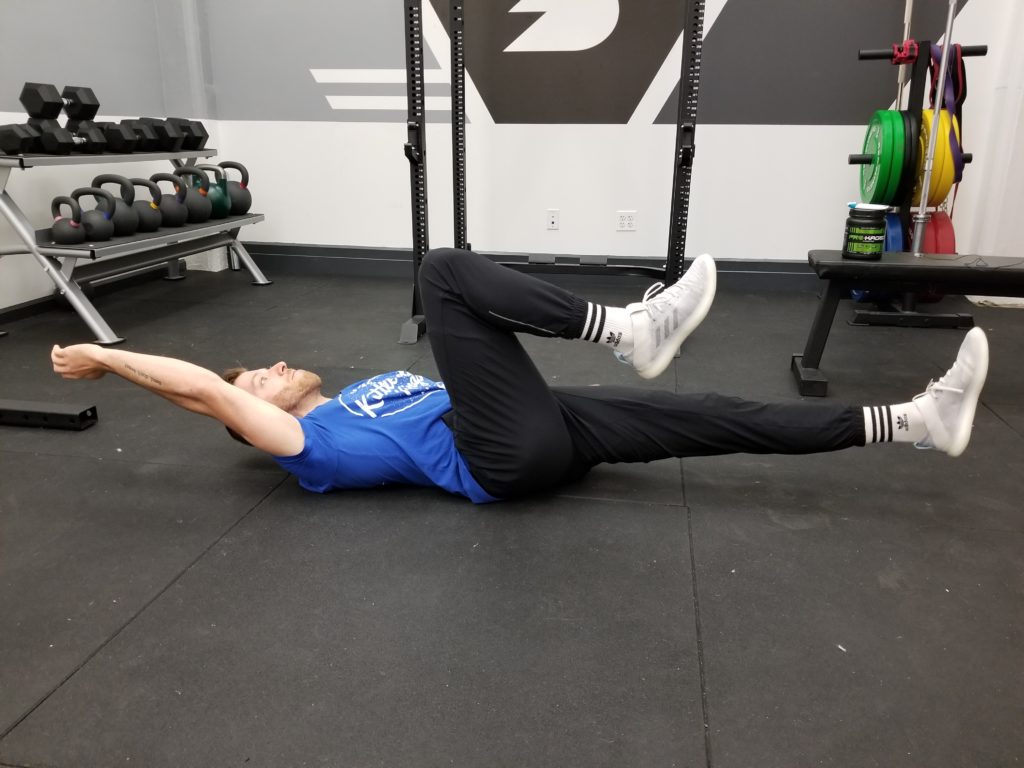
2.
Start the Dead Bug
To begin the dead bug, extend one leg and arm that are located diagonally from one another while maintaining a contracted core.
If you kick out the left leg, then the right arm will move above the head. The opposing arm can remain extended or move to the side of the body, and the opposing leg will remain in a flexed starting position.

3.
Transition to the Next Rep
After you’ve hit the first position/rep, transition to the next rep by repeating a similar movement with opposing arms and legs.
Coach’s Tip: Make sure you core remains contracted throughout the full movement and the lower back is flush with the floor.
2. Planks and Side Planks
The plank is a foundational isometric core strengthening exercise that can be done with or without load. In the early stages of a lifting career, amply emphasis should be on maintaining proper alignment and resisting spinal extension, flexion. Over time, a neutral spinal positioning can be reinforced using weighted planks and side planks.
Strong planks can lead to increase core stability and rigidity under load; such as with loaded squats, pulls, dynamic locomotive movements, and even bodyweight exercises.
How to Properly Plank
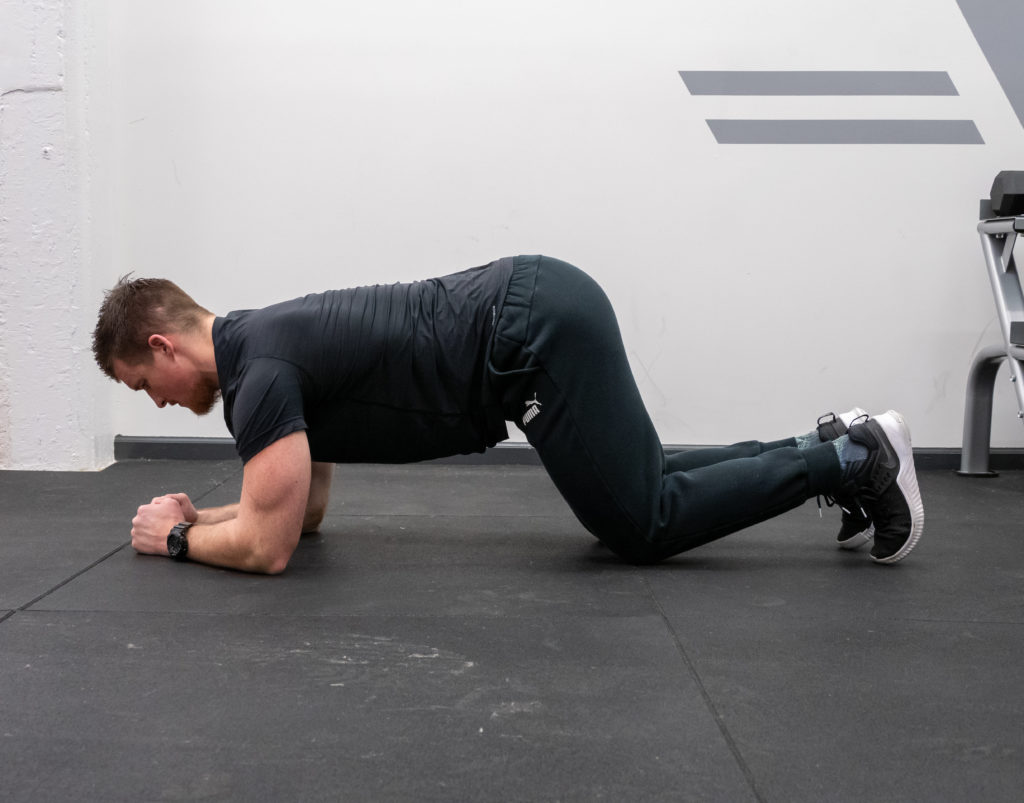
1.
The Setup
To get into position for a standard plank, place the feet and knees on the ground, then place the forearms under the upper body.
The goal is to contract the core and maintain a strong body alignment void of sagging hips and shoulder retraction.
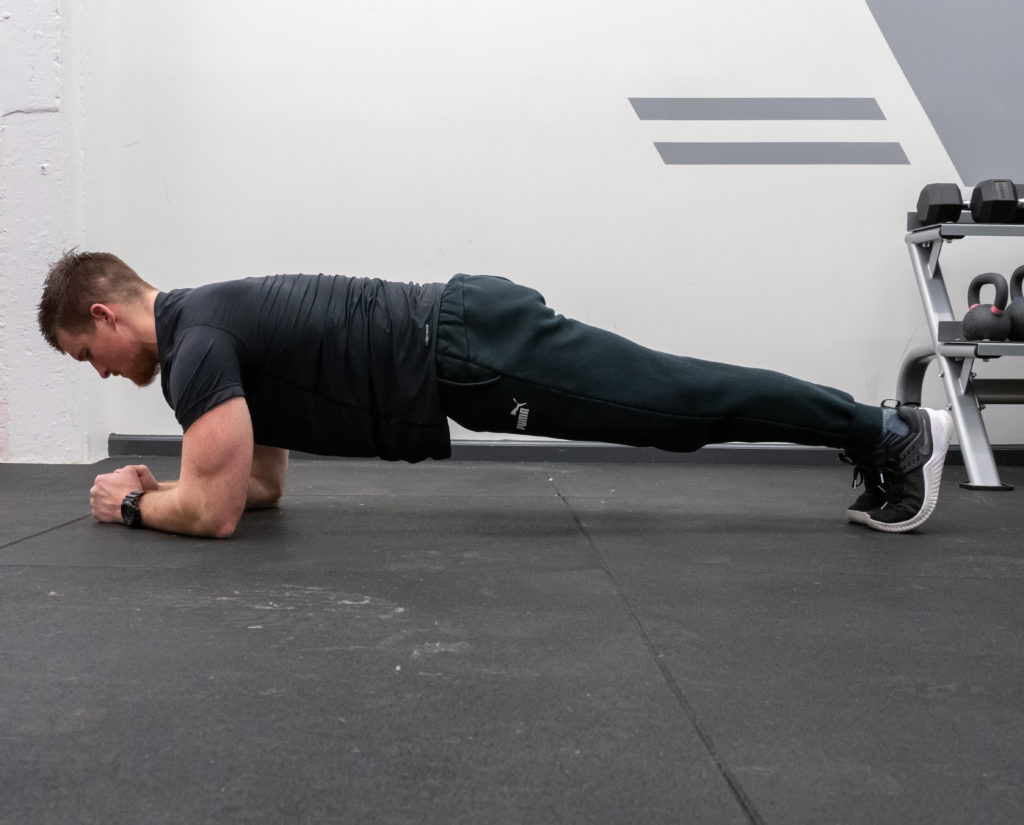
2.
Contract and Hold
Once the body is in proper alignment, contract the core and glutes, while driving the heels into the ground and protracting the scapula.
3. Pallof Press and Rotations
The Pallof press and its variations (rotations, overhead reaches, etc) is a core stability exercise that can challenge the isometric and dynamic strength properties of the core. Additionally, the Pallof press can be used to educate and reinforce proper signal stability, alignment, and develop tension during bracing movements.
To do this, a lifter can perform isometric holds, holds with overhead reaches, and do so from a variety of angles to bulletproof the core using bands and/or cable resistance.
4. McGill Curl-Ups
The McGill Curl-Up is named after Dr. Stuart McGill, renowned biomechanics professor and advocate on core stability and lower back pain. The McGill Curl-up is a sit-up variation that can be done to increase rectus abdominal muscular endurance and strength while minimizing forces placed upon the lumbar spine.
This partial range of motion crunch/sit-up is a good exercise to educate lifters of how to properly contract core muscles without producing stress upon the lower back. Additionally, many beginners use their upper torso to perform sit-ups (due to weakness). This exercise can be a good regression to increase fundamental core strength and muscular endurance.
5. Cable/Band Chops
Rotational training isn’t just for athletes. Learning how to resist spinal rotation while contracting the obliques and promoting dynamic movement is key for core development and injury prevention.
Much like the Pallof press, many beginners can benefit from integrating cable chops and rotational training into their program. The cable/banded chop can aid in building the obliques and reinforce functional movement patterns for everyday activities.

6. Rollouts
Ab rollouts can be done with an ab wheel, physioball/Swiss ball, or even a foam roller; all of which increase the eccentric strength and coordination of the abdominals. The abdominals work to resist spinal extension with the ab rollout helping to reinforce proper core stability and a neutral spine.
This is a very challenging exercise, and can often be done incorrectly due to excessive lumbar extension when fully rolled out. Be sure to keep the spine neutral and allow the hips to flex and extend freely as the abdominals stay contracted.
How to Do Swiss Ball Rollouts
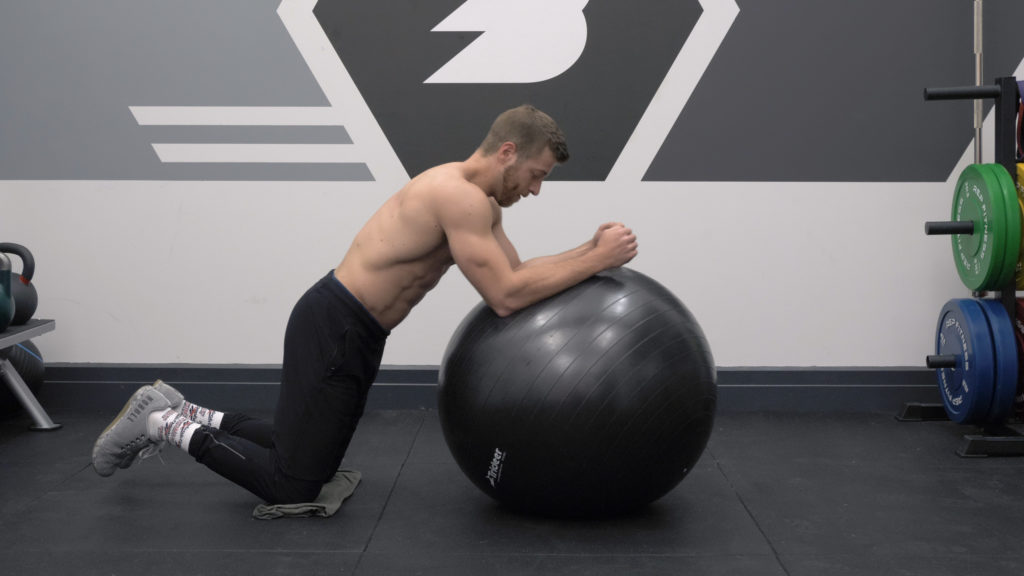
1.
Setup Properly
Begin by placing the knees on the ground on a padded surface and bring a Swiss Ball in front of the body.
Place the arms on the ball with the elbows in a 90 degree angle. Brace and contract the core before initiating the rollout.

2.
Initiate the Rollout
After you’ve established a strong starting position and the core is contract, begin roll the forearms out on the Swiss Ball. Initiate the movement by keeping the lats contracted and the arms in a fixed position.
As the Swiss Ball rolls out, focus on keeping a contracting the core and maintain and a strong arm angle.

3.
Finishing the Rollout
Extend the arms to point where you can maintain a contracted core and the lumber is void of extension. The degree in which the ball will rollout should be based on one’s strength level — there is no one-size-fits-all!
When bringing the ball back into the body, focus on creating a core contraction as opposed to starting the roll the arms.
7. Hanging Knee/Leg Raise
The hanging knee/leg raise is a great exercise to develop midline stability and build the rectus abdominis. This exercise is done by hanging with the legs pressed together. The lifter must begin in the bottom position with the core contracted, much like in a hollow position. As the lifter pulls the knees upwards into the body, they should feel the rectus abdominis and hip flexors engage.
As the lifter develops greater core strength and endurance, the can progress this exercise into straight leg raises, strict toes to bar, and L-sit holds.
Don’t Forget the Glutes!
The glute muscles, while not part of the core, are key muscles used to assist in providing the stability and strength in most loaded, unloaded, and athletic movements. Lack of glute strength and coordination can result in pelvic, knee, and hip instability and lower back strain.
Check out the below articles and discussing the importance of glute-specific training and start building a strong core (and glutes) today!
Feature image from Ivanko80 / Shutterstock.